NOVEMBER 2014
Misdemeanor Arrests Rise Despite Record Low Crime Rates, Study Finds
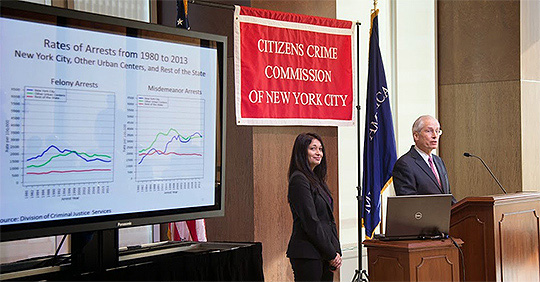
President Jeremy Travis and Professor Preeti Chauhan present the findings of an analysis of misdemeanor-arrest trends at a Citizens Crime Commission forum.
The number and rate of misdemeanor arrests in New York increased sharply from 1980 to 2013, with the greatest impact being felt by young minority men, according to a new study unveiled on Oct. 28 by President Jeremy Travis and Professor Preeti Chauhan.
The study examined data from the New York Police Department, the New York State Division of Criminal Justice Services and the United States Census, marking the first time a comprehensive, comparative data set had been created to analyze the arrest trends. The findings were presented at a breakfast forum hosted by the Citizens Crime Commission of New York.
Led by Chauhan as Principal Investigator, the research team of faculty, staff and graduate students drew four key conclusions from the data:
- New York City, along with other cities in the state, experienced significant increases in the number and rate of misdemeanor arrests from 1908 to 2013.
- Young minority men experienced the greatest increases in misdemeanor arrests in New York City.
- There is significant variation in New York City in the charges related to these arrests, how they are initially processed, and their disposition and subsequent sentence.
- The increases in misdemeanor arrests were not uniform across New York City, with significant variation by precinct.
“Taken in a historical context,” said Travis, “these data trends represent a profound shift in our city. Crime is down to historic lows, felony arrests have dropped in half, yet the rate of misdemeanor arrests has tripled.” Through an in-depth analysis of the arrest trend, Travis added, researchers hoped “to promote an important policy discussion about this aspect of our approach to crime and justice.”
Chauhan pointed out that while the study found significant increase in misdemeanor arrests among young minority men, equally noteworthy is “the sharp decline in misdemeanor arrest rates since 2010 for the same demographic group.”
Funding for “Trends in Misdemeanor Arrests in New York” was provided by the Laura and John Arnold Foundation. The report will be followed by a detailed analysis of summonses, as well as a symposium on misdemeanor justice in 2015.
MPA Programs Honored for Diversity, Social Equity
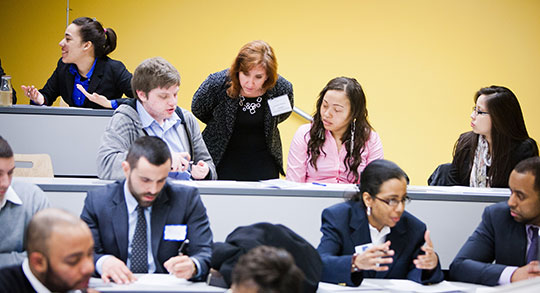
Score one — better make that two — for John Jay’s master’s degree programs in public administration, which were recently selected as the winners of both the Diversity Award and the Social Equity Award by the Network of Schools of Public Policy, Affairs and Administration (NASPAA), the recognized global accreditor of graduate programs in these fields.
“This is a great honor that reaffirms our mission and underscores the talent and commitment of the John Jay faculty,” said President Jeremy Travis. “The increasing number of graduate students who choose to come to John Jay confirms the quality of the educational experience here.”
According to NASPAA, the Diversity Award and the Social Equity Award are “given to a public policy, affairs or administration program that exemplifies the highest standards” in diversity and in social equity, through outstanding contributions in research, teaching and service by faculty and staff. Separate NASPAA committees reviewed applications and chose the winner for each award category.
John Jay College offers two Master of Public Administration tracks — Public Policy and Administration, which won the Diversity Award, and Inspection and Oversight, which won the Social Equity Award. John Jay’s combined MPA programs are among the largest in the country.
Said Professor Marilyn Rubin, the Director of the Public Policy and Administration program: “We are very excited about receiving this award that acknowledges our diversity efforts.” The MPA -PPA program, she noted, is inspired and guided by John Jay College’s mission to “...foster an inclusive and diverse community drawn from our city, our country, and the world.”
Professor Ned Benton, the Director of the Inspection and Oversight Program, observed that John Jay College is a special place with a unique MPA program in Inspection and Oversight. “Both the field of inspection and oversight and the John Jay College MPA-IO program seek to promote a fair, just and equitable distribution of public services and implementation of public policies,” Benton said.
NASPAA is an international, 300-member organization of graduate education programs in public policy, public affairs, public administration, and public and nonprofit management.
Diplomacy Lab Project Puts Students’ Research Efforts to the Test
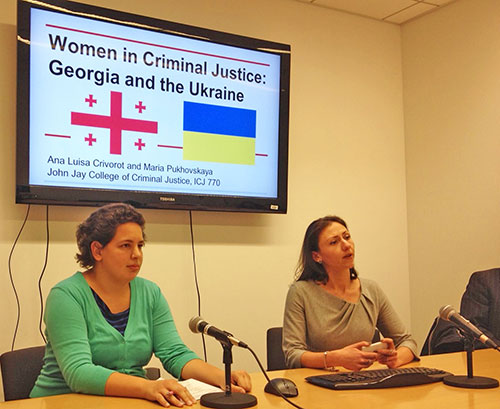
Ana Luisa Crivorot and Maria Pukhovskaya, students in the capstone seminar in International Criminal Justice, were among those who did a Skype presentation of draft reports to the State Department as part of the Diplomacy Lab initiative.
The intellectual power of John Jay students is being harnessed by the U.S. State Department through the new Diplomacy Lab initiative, which provides the students with an opportunity to conduct research into real-world foreign policy challenges.
John Jay is one of 14 universities and colleges nationwide that are participating in the Diplomacy Lab’s pilot phase this semester. The College was chosen to mount four research studies, under the guidance of faculty members and conducted in the context of undergraduate and graduate courses.
Sociology Professor Rosemary Barberet, along with political science Professor Susan Kang, is overseeing one of the Diplomacy Lab projects as part of the capstone seminar in the master’s program in International Criminal Justice.
Focusing on “Women in Criminal Justice: Measuring Outcomes” for their Diplomacy Lab project, five teams of two students each will study reforms aimed at increasing the recruitment and retention of women as criminal justice professionals in Afghanistan, the Democratic Republic of Congo, Costa Rica, Egypt and Lebanon — all post-conflict or post-transition countries identified by the State Department.
“We tell the students that this is essentially a short-term consultancy,” said Barberet. And, like most consultants, the students will be expected to produce a report that includes an executive summary and key policy prescriptions. Throughout the semester, students work directly with State Department officials via video- or teleconferences.
Along the way, students participating in the four Diplomacy Lab projects can expect a few challenges, beginning with the difficulty of finding usable pre-existing research literature. “Students have come to recognize the challenges of looking outside the box when it comes to research,” Barberet noted, ”and some of them are a bit perplexed at how little they’re finding.”
Once students have amassed their research findings and the data from expert interviews, each team is required to prepare a 15-page paper, along with a cumulative, class-based 20-page final project report.
In addition to the capstone seminar’s examination of Women in Criminal Justice, the Diplomacy Lab at John Jay this semester also includes research into Trafficking in Persons and Human Rights, led by Barberet and Kang; U.S. Foreign Policy Options to Tackle Migration in the Mediterranean Sea, an independent study for graduate and doctoral students led by Professor George Andreopoulos of the Department of Political Science and Michalis Tsiniszelis of the University of Athens; and Criminal Justice Responses to Wildlife Trafficking as a Crime, the focus of an undergraduate research-methods course led by Professor Gohar Petrossian of the Department of Criminal Justice and doctoral student Julie Viollaz.
Petrossian, whose specialty is wildlife trafficking, says she was surprised at her students’ enthusiasm for what she concedes is not a mainstream topic. “Normally, in Research Methods, students have to come up with their own topics,” she said. “I didn’t expect this level of interest.”
The State Department asked for a focus on illegal fishing as well as trafficking in four “mega-fauna” — elephants, tigers and rhinoceroses — with an emphasis on law enforcement responses at the country level, including an evaluation of effectiveness and policy recommendations. Once again, students will be expected to think outside the box for research materials.
“This is about more than just academic articles,” said Viollaz, whose dissertation will explore illegal leopard poaching. “There’s just not as much data on this topic,” she said, “so they’ll be looking at non-traditional sources, media reports, NGO reports, etc.” Yet any paucity of information seems unlikely to diminish the young researchers’ passion for the subject. “This is a way to increase awareness,” said Adriana Alvarado, a junior. “Animals need a voice, and we can be that voice.” Monnero Guervil, also a junior, plans to take the research one step further by studying abroad in South America during the winter session to look into human and wildlife issues.
Daniel DeStefano, who along with fellow senior Francisco Nuñez is researching illegal fisheries, sees a practical, more long-term aspect to the Diplomacy Lab research. “This is work experience that we can’t replicate in class,” he observed. “It could be helpful in the future, and could be a topic to follow up on after John Jay.”
Students’ names are on the final reports as primary authors, Petrossian pointed out, which Nuñez said means “you leave college with something besides a diploma.”
Added Barberet: “It’s not often that you can list a specific class on your résumé, so this is a good thing for students. But it’s a two-way street. Like any internship, you get what you give.”
Pursuing a Dream, from Trinidad to John Jay
 Simonne Isaac, by her own admission, is committed to “enriching the lives of others.” Now, with the help of a fellowship award from the Education Fund of the Women’s Forum of New York, she will be better positioned to making her dream a reality.
Simonne Isaac, by her own admission, is committed to “enriching the lives of others.” Now, with the help of a fellowship award from the Education Fund of the Women’s Forum of New York, she will be better positioned to making her dream a reality.
The Education Fund fellowship provides $10,000 in student support to help mature women to fulfill their potential through the pursuit of an undergraduate college education and to enhance their capacity for meaningful community service. According to the Women’s Fund’s website, the award recognizes “extraordinary and often heroic effort in overcoming adversity and the most daunting of odds in restructuring lives for success.” It’s a succinct description of the path Isaac has taken.
A senior English major, with a minor in Film Studies, Isaac is an Honors Program student and Peer Ambassador at John Jay. She left a government job as a firefighter in her native Trinidad and Tobago to immigrate to the United States in search of a better life for herself and her family. By her own admission, it took every ounce of courage she could muster to leave her comfort zone and pursue her dreams.
Along the way, she learned to motivate herself and surround herself with high achievers who refuse to accept mediocrity. That approach factors into the advice she often gives new student in her role as Peer Ambassador. “Take advantage of the resources available on campus,” she urges, “and especially build relationships with professors.
“The faculty and staff are geared toward my success,” she continued. “They take an active role in my education, and help me to develop as an all-round person, not just as an academic student.”
Through volunteer work as a secretary with her small but growing church, Isaac cultivated an interest in nonprofit organizations that are focused on social justice issues. Her sights are now set on going to law school, with the intention of specializing in public-interest law.
“My experiences with nonprofit organizations have reinforced my desire to assist organizations that are dedicated to enriching the lives of others,” she said. “As I have been an aid recipient from such groups, I am committed to ‘paying-it forward.’ ”
Play Ball! Four New Coaches Take Charge for the Bloodhounds

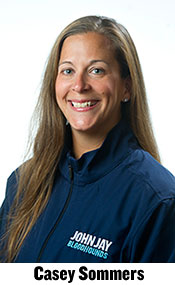
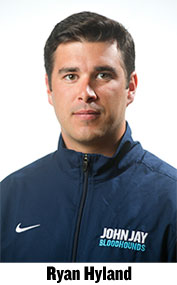

The 2014-2015 school year got underway for John Jay Athletics with four new faces in head coaching roles.
The men’s and women’s soccer teams, which began play in early September, are being led by Bradley Johnson and Casey Sommers, respectively. Sommers is a “perfect fit for our program,” said Director of Athletics Carol Kashow, with a “proven track record and years of coaching experience.”
Sommers, a Brooklyn native, played Division I soccer at Fordham University, and was an assistant coach there from 2005-2014, helping to lead the team to four Atlantic 10 conference championships. At John Jay, Sommers said, she hopes to “promote a winning environment where students can thrive on and off the field.”
Johnson was assistant coach of the men’s soccer coach last season. He has played college soccer in the U.S. at the Division I and Division III levels, as well as in Brazil, Croatia, England and the Netherlands. Johnson holds a master’s degree in Sport and Exercise Psychology from Brunel University in Middlesex, England.
Men’s and women’s basketball will also play under new leadership, with the addition of Ryan Hyland and MollyAnne Light to the Athletics staff. Hyland is a Breezy Point, N.Y., native who played and served as an assistant coach at Catholic University of America, a Division III program in Washington, D.C. “I am humbled and honored by this opportunity to join the John Jay family, to return to NYC to a great institution with an amazing vision to succeed,” Hyland said.
Light comes to John Jay from Camden County College in New Jersey, where she was the head women’s basketball coach from 2011-2014. A multi-sport athlete herself, Light has coached basketball at the junior high school, high school and junior college levels. “I am really excited,” she said. “I plan to bring in new talent and to really try to make an impact in the conference this year.”
The basketball season begins in mid-November, with the annual Homecoming Day celebration set for Dec. 9.
Peer Mentor Program Earns National Honors
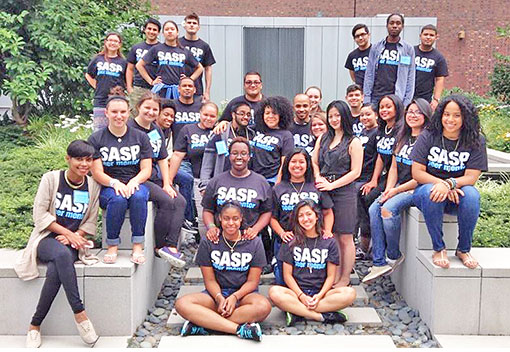
Coordinator Nancy Yang (center, in a dress) and the 2014-2015 SASP Peer Mentors on the Jay Walk.
Peer mentors can help smooth the transition to college life for entering freshmen, and John Jay’s 30-member cadre of peer mentors tackles this challenge better than most — so much so that NASPA, the Association of Student Affairs Professionals in Higher Education, recently presented the mentoring program with a Spotlight Series Award for Influences on Student Learning.
The award from NASPA’s Student Leadership Programs Knowledge Community is the third such honor in 13 months for a John Jay support program. It represents a “wonderful recognition of your vision for the Peer Mentors and your continuous good work with them so that they bring out the best in all of our first-year students,” interim
Dean of Undergraduate Studies Allison Pease noted in an e-mail to Nancy Yang, Coordinator of the Peer Mentoring Program, and Kate Szur, Senior Director of Student Academic Success Programs, which includes the mentoring effort.
Each of the Peer Mentors is assigned to one of John Jay’s 46 First-Year Seminars, Yang explained. “They’re academically successful, and they serve as your companion, your helper, your coach, with things like time management, how to manage a syllabus, or organize a calendar.”
Mentors work with an average of 50-75 students each. The freshman peer mentoring effort includes ADELANTE/CREAR Futuros (College Readiness, Achievement and Retention), a program designed to support Latino student success, and there is a similar mentoring program for transfer students, especially those who come to John Jay through the CUNY Justice Academy.
“The SASP Peer Mentoring Program is my baby,” Yang said with evident pride, “and I’m very blessed to never have had Peer Mentors lacking motivation.” The mentors, she pointed out, are all proactive, e-mailing the students they work with every week, calling them once a month, and sitting in classes with the mentees throughout the semester. They report to Yang regularly on their activities and concerns.
“Part of what we want to build is the value of networking,” said Yang, “and the importance of learning in and out of the classroom.” Many current Peer Mentors, she noted, joined the program after having been inspired by their former mentors. “It’s a cycle of success and leadership,” she said.
Recognizing Grief Turned to Action
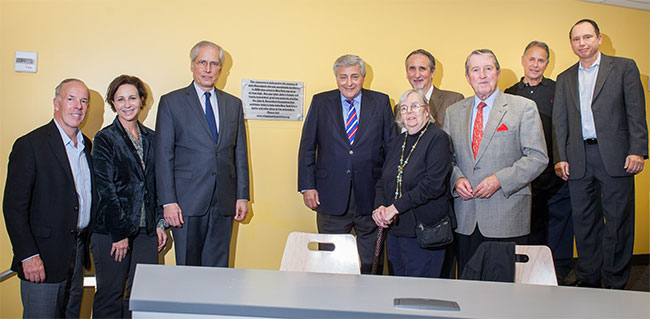
Family and friends of the late John Reisenbach gathered on Oct. 22 for a dedication ceremony naming a classroom in the new building in his honor. The plaque to the right of President Jeremy Travis reads: “This classroom is dedicated to the memory of John Reisenbach who was senselessly murdered in 1990 when crime in New York was at an all-time high. One year later, John’s friends and family turned their grief into action by starting the John A. Reisenbach Foundation that continues today to help make New York City a better and safer place to live and work in. Please visit www.reisenbachfoundation.org.” Among the initiatives funded by the foundation are the John A. Reisenbach Master’s Scholarships at John Jay, for graduate students in criminal justice, forensic science or forensic psychology.
Let the Sun Shine In. . .
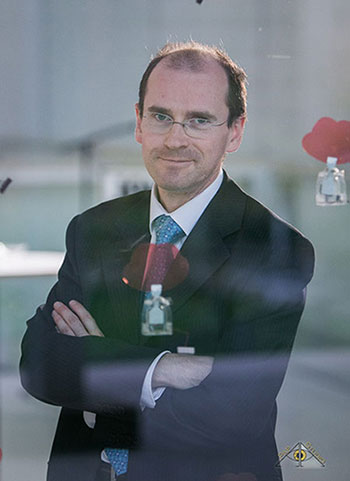
Acclaimed environmental artist Alexandre Dang’s latest installation, “Dancing Solar Flowers,” was dedicated Oct. 15 as part of John Jay’s yearlong 50th anniversary celebration. Mounted on windows overlooking the Jay Walk, the exhibition consists of individual elements, in this case flowers, that are solar powered to allow them to rock back and forth. The installation is intended to focus attention on alternative energies and society's need to address environmental issues. "This is socially conscious art that prompts reflection upon respect for the environment, sustainable development, forms of renewable energy, and more generally, the sustainability of our modes of production and consumption,” the French-born artist noted.
Ringing a Bell for Veterans. . .

In commemoration of Veterans Day, for the second consecutive year, President Jeremy Travis rang the opening bell at NASDAQ OMX Stock Market. At the President’s side were John Jay student veterans and administrators, as well as Peter Beshar, Trustee of the John Jay College Foundation Board and Chair of the Veterans Committee of the Board. Representatives from companies participating in John Jay’s Veterans Corporate Roundtable and veteran-friendly corporations listed on NASDAQ were also in attendance.
